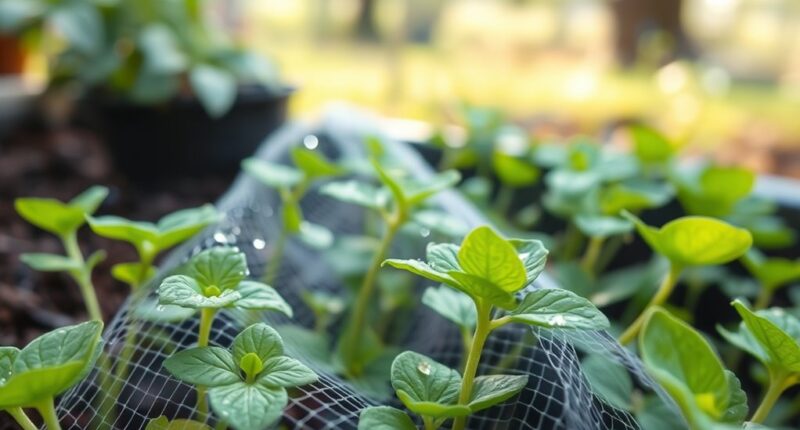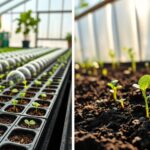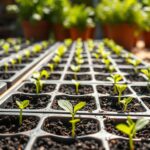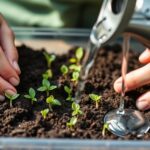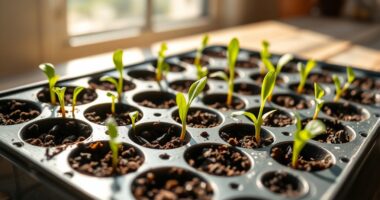Hardening off seedlings helps them adapt safely to outdoor conditions, preventing stress, transplant shock, or damage. To do this, start by placing your seedlings outside in shaded, sheltered areas for a few hours each day, gradually increasing exposure over about a week. This process helps them strengthen against wind, sun, and pests. If you want to make sure your seedlings thrive when planted out, keep learning how to make this shift smooth.
Key Takeaways
- Hardening off helps seedlings adapt gradually to outdoor conditions, reducing transplant shock and promoting healthy growth.
- Start with short outdoor periods in shaded areas, gradually increasing exposure over about a week.
- Protect seedlings from pests and harsh weather during the transition with barriers and weather checks.
- Gradual exposure strengthens seedlings against wind, sun, and pests, ensuring a successful garden establishment.
- Remove seedlings from protective covers once fully acclimated to outdoor conditions, preventing damage and stress.
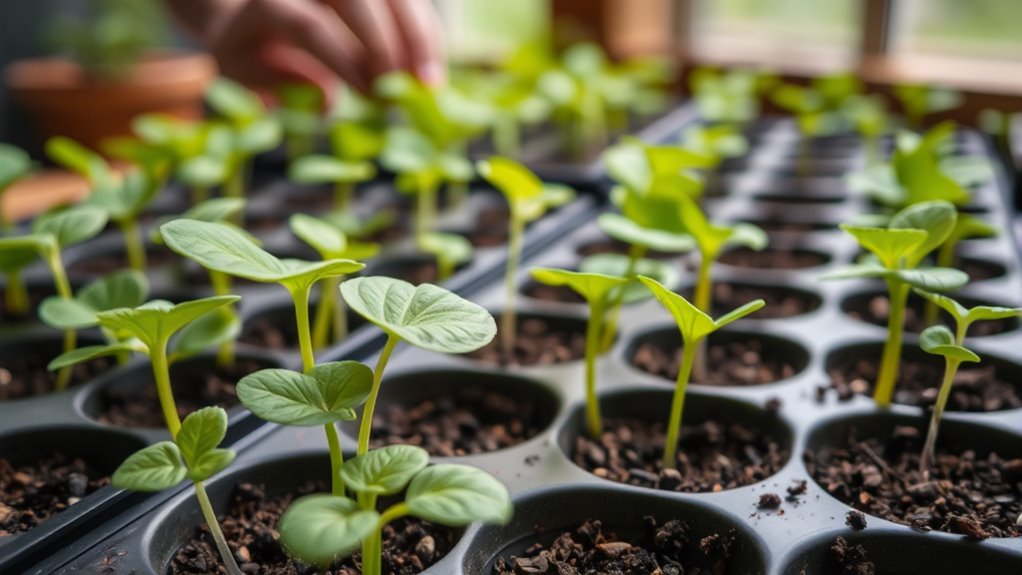
Hardening off seedlings is a vital step to guarantee they adjust successfully to outdoor conditions before planting them in your garden. If you’ve been nurturing your plants indoors, you’re probably familiar with the controlled environment that shields them from harsh weather, pests, and temperature fluctuations. But when it’s time to move them outside, they need a gradual transition. This process helps your seedlings build resilience, prevents shock, and ensures they thrive once planted. Think of it as a gentle introduction to the world beyond your windows.
Hardening off seedlings helps them adapt gradually for outdoor success.
The first step in hardening off is to start exposing your seedlings to outdoor conditions gradually. Begin by placing them outdoors for just a couple of hours on a mild, calm day. Choose a shaded spot initially to shield them from direct sunlight, which can be too intense for tender indoor growth plants. Over the course of a week or so, increase the exposure time gradually each day, ensuring they get accustomed to the outdoor air, wind, and sunlight. This slow process helps prevent transplant shock, which can make your plants weak or cause them to wilt. Gradual exposure also gives you a chance to monitor how your seedlings respond to outdoor stressors and adjust accordingly.
While hardening off, you also protect your plants from pests that are more prevalent outside. An abrupt transition can leave seedlings vulnerable to pests such as aphids, slugs, or beetles, which may not have been present in your indoor environment. By introducing your plants gradually, you give yourself time to observe and manage pest risks. Keep an eye out for signs of pests and consider using physical barriers like row covers or fine mesh to prevent them from settling on your young plants. This is especially important during the initial outdoor exposure, as pest prevention is easier with fewer pests attacking stressed or weakened seedlings.
Remember that weather conditions can change quickly, so check the forecast before exposing your seedlings to the outdoors. Avoid days with high winds, heavy rain, or intense sun during the first few days of hardening off. Wind can damage delicate stems, and direct sunlight can scorch leaves that haven’t yet adapted. When you’re confident your seedlings are acclimated, you can remove them from their protective shelter entirely and plant them in your garden.
Frequently Asked Questions
How Long Should I Harden off My Seedlings?
You should plan a hardening schedule that spans about 7 to 14 days, depending on your seedlings and local conditions. The acclimatization duration allows your plants to adjust gradually to outdoor environments. Start by exposing them for a few hours daily, then increase the time and outdoor exposure each day. This method helps prevent shock, ensuring your seedlings strengthen and grow healthy before transplanting.
Can I Harden off Seedlings Indoors?
Think of hardening off like preparing a guest for the outdoors; you can start indoors, but it takes patience. You can definitely harden off seedlings indoors by gradually increasing their exposure to outdoor conditions, even with just indoor lighting. Keep a consistent watering schedule, ensuring they don’t dry out or get soaked. This gentle shift helps your plants adapt smoothly, making them stronger and more resilient when they finally go outside.
What Signs Indicate My Seedlings Are Ready for Hardening?
You’ll know your seedlings are ready for hardening when they show steady growth indicators like strong stems and healthy leaves. Look for minimal plant stress signs, such as wilting or discoloration, which suggest they’re not quite ready. Gradually exposing them to outdoor conditions helps them adapt without shock. If they handle increased sunlight and wind without stress, it’s a clear sign they’re ready to be hardened off safely.
How Does Weather Affect the Hardening off Process?
Weather impacts your hardening off process like a gentle breeze influences a sailboat, guiding its way. You should consider climate considerations and daily weather patterns, as sudden cold snaps or intense sun can stress your seedlings. Gradually expose them to outdoor conditions, monitoring temperature and wind, to prevent shock. Keep an eye on forecast updates, adjusting your schedule accordingly, so your seedlings adapt smoothly without weather-related setbacks.
Are There Specific Plants That Require Special Hardening Techniques?
Some plants, like tropical plants and shade lovers, need special hardening techniques. You should gradually expose them to outdoor conditions, starting with limited sunlight and cooler temperatures. Tropical plants, for instance, require a slow progression from warm indoor environments, while shade lovers benefit from protection against direct sun initially. By adjusting their exposure carefully, you help them adapt, preventing shock and promoting healthy growth once fully acclimated outdoors.
Conclusion
Hardening off your seedlings is like preparing a delicate dancer for the grand stage—gradually building strength and resilience. By slowly exposing your plants to outdoor conditions, you help them adapt and thrive beyond your windowsill. Skipping this step is like rushing a storm’s calm before it’s ready; it can leave your plants vulnerable. Take your time, be patient, and watch your seedlings blossom into hardy, vibrant plants that will flourish in their new environment.
